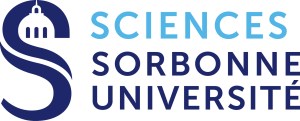PolSys Seminar
This seminar focuses mainly on computer algebra algorithms and implementations for solving mathematical problems exactly, with a special focus on polynomial system solving and its broad range of applications.
Among others, topics which are covered are:- Foundational computer algebra algorithms for polynomials, series and matrices
- Polynomial system solving with algebraic and/or certified numerical methods
- Applications of non-linear algebra algorithms such as cryptography, polynomial optimization, and computational geometry
Campus Pierre-et-Marie-Curie
Sorbonne Université
4 place Jussieu
75005 Paris, France
To receive further anouncements, register for the mailing list here:
Upcoming seminars and events
-
16th January 2026, 11:00seminar
Yulia Mukhina
École polytechnique, Palaiseau -
13th February 2026, 11:00seminar
Mahsa Naraghi
IRIF, Paris -
20th February 2026, 11:00seminar
Joris van der Hoeven
CNRS, École polytechnique, Palaiseau -
24th February 2026, 16:00seminar
Manuel Kauers
Univ. J. Kepler, Austria -
27th March 2026, 11:00seminar
Simona Samardjiska
Digital Security Group, Radboud University -
10th April 2026, 11:00seminar
Tristan Vaccon
XLIM, Univ. de Limoges
Next seminars
New Algorithms for Elimination in Differential Dynamical Systems Based on Support Bounds
16th Jan. 2026
11:00
25-26/105
Abstract.
Differential algebra is the branch of algebra that studies differential
equations from an algebraic standpoint,inspired by the way polynomial equation
are studied using algebraic geometry.
A key topic in this field is the elimination of variables. More precisely, given
a system with several variables, we aim to describe the differential relations satisfied
by a selected subset of those variables. Elimination is used to analyze systems of
differential equations, especially in the context of dynamical systems models where data
is available only for a subset of the variables.
In this talk, we provide an overview of existing tools for differential elimination
and discuss their potential applications. We present our main result: the characterization
of the set of terms that can appear in the resulting polynomial after elimination. Based on
this result, we introduce an algorithm and demonstrate that our implementation can handle
problems that are beyond the capabilities of current state-of-the-art software for differential elimination.
We also discuss a new approach to computing so-called mixed fiber polytopes in the context of
polynomial elimination. We demonstrate the practical performance improvements of our algorithm
compared to existing methods and highlight an application of this work to differential elimination.
Joint works with Gleb Pogudin and Rafael Mohr.
École polytechnique, Palaiseau
TBA
TBA
Flip Graphs for Matrix Multiplication
24th Feb. 2026
16:00
25-26/105
Abstract. There have been several works recently on getting sharper upper bounds for the tensor rank of matrix multiplication tensors for small and specific matrix formats. One of the techniques applied in this context is the flip graph method introduced by Jakob Moosbauer and the speaker at ISSAC'23. In the talk, we will explain this method, discuss its pros and cons, and summarize the results we obtained with it so far.
Univ J. Kepler, Austria
TBA
27th Mar. 2026
11:00
24-25/405
Abstract.
Digital Security Group, Radboud University
Learning to Compute Gröbner bases
10th Apr. 2026
11:00
25-26/105
Abstract. Computing a Gröbner basis has been a fundamental task in computational algebra for more than 50 years. However, it is also known for its notorious doubly exponential time complexity in the number of variables in the worst case. In this talk, I present a new paradigm for addressing such problems, i.e., a machine-learning approach using a Transformer model. This is a joint work with Hiroshi Kera, Yuki Ishihara, Yuta Kambe, Yota Maeda, et Kazuhiro Yokoyama. The learning approach does not require an explicit algorithm design and can return the solutions in (roughly) constant time. This talk covers our initial results on this approach and relevant computational algebraic and machine learning challenges. In particular, the learning approach needs a large-scale dataset of couples of non-Gröbner sets and Gröbner bases generating the same ideal. This gives rise to underexplored open problems: the random generation of Gröbner bases and their ideal-invariant transformation into non-Gröbner sets, the structure of GL_n (k[X_1,...,X_n]) and its relation to effective version of the Quillen-Suslin theorem.
XLIM, Univ. de Limoges
Past seminars
Some results about the central configurations of 5 bodies obtained by polynomial elimination
12th September 2025
11:00
55-65/211
Abstract.
The central configurations of the Newtonian n-body problem are configurations
of n point bodies, each with a positive mass, such that the Newtonian
attraction may be exactly balanced by a centrifugal force. For example, a
planar central configuration may rotate uniformly around its center of mass,
thus defining a relative equilibrium of the n-body problem. Astronomical
examples with n=3 are the Trojan asteroids and other bodies at some Lagrange
point.
In 1995 I proved that there are only four types of central configurations of 4
bodies with equal masses, by using polynomial elimination. Here I wish to
determine the central configurations of 5 bodies which have 3 bodies on a
line. I will solve this problem in a symmetric case, where the existence
result was published by Marian Gidea and Jaume Llibre in 2010, and
independently by Kuo-Chang Chen and Jun-Shian Hsiao in 2011.
Observatoire de Paris, CNRS
Linearised Chinese Remainder Codes
26th Sep. 2025
10:30
25-26/105
Abstract.
We introduce a new family of rank metric codes. The construction
of these codes relies on the "Chinese Remainder Theorem" for
linearised polynomials. Linearised polynomials are polynomials
in which the exponents of all the monomials are powers of q and
the coefficients come from an extension field of the finite
field of order q. The set of these polynomials forms a right
Euclidean ring. We present the lifting of the isomorphism of the
Chinese remainder theorem for linearised polynomials. We show
how this lifting leads to a decoding algorithm for a special
case of this family of codes: the case where the linearised
polynomials have coefficients in the finite field of order q.
(Joint work with Olivier Ruatta and Philippe Gaborit).
(The slides of this talk are available
here.)
XLIM, Limoges
The Tangent Space Attack
3rd Oct. 2025
11:00
24-25/405
Abstract.
We propose a new method for retrieving the algebraic structure
of a generic alternant code given an arbitrary generator matrix,
provided certain conditions are met. We then discuss how this
challenges the security of the McEliece cryptosystem
instantiated with this family of codes. The central object of
our work is the quadratic hull related to a linear code, defined
as the intersection of all quadrics passing through the columns
of a given generator or parity-check matrix, where the columns
are considered as points in the affine or projective space. The
geometric properties of this object reveal important information
about the internal algebraic structure of the code. This is
particularly evident in the case of generalized Reed-Solomon
codes, whose quadratic hull is deeply linked to a well-known
algebraic variety called the rational normal curve. By utilizing
the concept of Weil restriction of affine varieties, we
demonstrate that the quadratic hull of a generic dual alternant
code inherits many interesting features from the rational normal
curve, on account of the fact that alternant codes are
subfield-subcodes of generalized Reed-Solomon codes. If the rate
of the generic alternant code is sufficiently high, this allows
us to construct a polynomial-time algorithm for retrieving the
underlying generalized Reed-Solomon code from which the
alternant code is defined, which leads to an efficient
key-recovery attack against the McEliece cryptosystem when
instantiated with this class of codes. Finally, we discuss the
generalization of this approach to Algebraic-Geometry codes and
Goppa codes.
(The slides of this talk are available
here.)
Inria, Paris
On the computation of the algebraic closure of matrix monoids
10th Oct. 2025
11:00
26-00/534
Abstract. Algbraic invariants plays a cental role in program analysis and verification, they provide a compact certificate for corrctness. A natural way to study them is through the algebraic closure of matrix monoids, which captures all the polynomial relations satisfied by the reachable configurations of linear or affine programs. Recent results show that given a finite set of rational matrices, the algebraic closure of the monoid they generate is effectively computable. This opens up new directions, ranging from the complexity of computing invariants to structural questions about orbit closures and algebraic groups. In this talk I will survey some of these problems and the techniques used to tackle them. I will begin with a polynomial-time algorithm for computing closures in the case of a single matrix, before moving on to the general case. I will then discuss the “reverse problem” for commutative matrices: given a set of polynomials, does their ideal define the orbit closure of an algebraic group? Finally, I will touch on connections with reachability and closure problems in one-counter systems (1-VASS). This talk is based on the following papers: arXiv:2407.09154, arXiv:2407.04626, arXiv:2507.09373.
University of Oxford, UK
On Learning Polynomial Recursive Programs
14th Nov. 2025
11:00
24-25/405
Abstract. We introduce the class of P-finite automata. These are a generalisation of weighted automata, in which the weights of transitions can depend polynomially on the length of the input word. P-finite automata can also be viewed as simple tail-recursive programs in which the arguments of recursive calls can non-linearly refer to a variable that counts the number of recursive calls. The nomenclature is motivated by the fact that over a unary alphabet P-finite automata compute so-called P-finite sequences, that is, sequences that satisfy a linear recurrence with polynomial coefficients. Our main result shows that P-finite automata can be learned in polynomial time in Angluin's MAT exact learning model. This generalises the classical results that deterministic finite automata and weighted automata over a field are respectively polynomial-time learnable in the MAT model.
IRIF, CNRS, Paris
Effective Artin-Schreier-Witt theory for curves
28th Nov. 2025
11:00
25-26/105
Abstract. In arithmetic geometry, Artin-Schreier-Witt theory gives a way to construct unramified covers of curves. However, nobody has ever made a full computation using these techniques. In this talk, we will explain how we implemented an algorithm which enables one to compute such covers. I will explain the motivation behind this problem, and the challenges that one faces using this theory. For our computations, it is necessary to have an algorithm which computes the fixed points of a Frobenius-semilinear map. I will also explain how to implement such an algorithm. This is a joint work with Christophe Levrat (Inria Saclay).
Inria, Saclay
Dynamics in differential and difference algebra
2nd Dec. 2025
15:00
55-65/211
Abstract.
Differential and difference algebra studies the algebraic aspect of differential and difference equations, which provides an algebraic foundation for symbolic computation of differential and difference equations. In this talk, we will first introduce a stability problem in differential and difference fields.
Secondly, we present some stability criteria for several classes of special functions. At the end of this talk, we will prove that all D-finite functions or P-recursive sequences are eventually stable.
(The slides of this talk are available
here.)
AMSS, Chinese Academy of Sciences
Current fast matrix multiplication spring: challenges and new directions
12th Dec. 2025
11:00
25-26/105
Abstract. This informal presentation provides an overview of the current state of small fast matrix multiplication algorithm development. We focus on finding compact rank tensor decompositions related to the bilinear map that computes the product of n×p and p×q matrices, where n,p and q are all less than 32. We review the main methods currently employed to construct the decompositions (with the smallest known tensor rank) and highlight the limitations of these approaches.
Univ. Lille, CRISTAL

